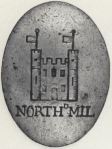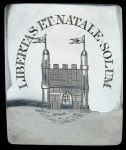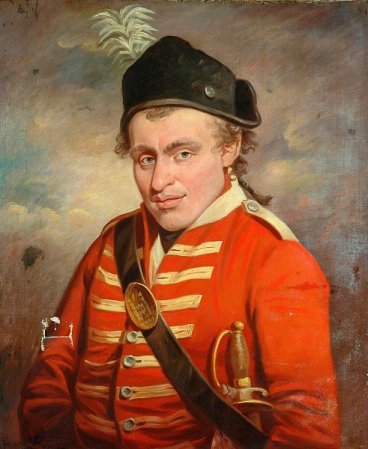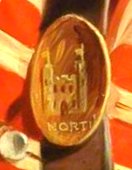Here’s a rather beautiful item I can’t resist posting, which bobbed up unexpectedly during some recent routine browsing. It was lot 56 in the vast and remarkable historic fashion collection of California collector Helen Larson, sold a year ago by Charles A Whitaker Auctions of Philadelphia, and was, I think, the single military item in the collection, most – or all? – of which seems to have been bought by the FIDM Museum of Los Angeles. Described simply as an anonymous “red wool military coat”, it is in fact an example of that rather overlooked garment, a light cavalry officer’s dress coat, and the buff facings and lining, the silver and buff braid, and the crown and “GY” buttons tie it incontrovertibly to the Grimston Yeomanry of East Yorkshire, the 1803 revival of the earlier East Riding Yeomanry detailed on this page. [Click to enlarge all images.]
When the light dragoon field uniform was radically replaced by a jacket and shell in 1784, the officer’s dress coat remained as prescribed in 1768, though now in dark blue. This oddity was ironed out in 1788, when a new dress coat was introduced; a fine drawing of an 11th Light Dragoons example of 1798, in the Welch and Stalker pattern book at the V&A, shows the new style to have been a version of the 1784 jacket, but with longer skirts and full double turnbacks edged with two rows of braid. (For the texts of the 1784 and 1788 orders, see Hew Strachan’s indispensable British Military Uniforms, pages 112 and 115.) This was certainly an update, but meanwhile the officer’s jacket had moved on to the 1796 closed “hussar” style, leaving the coat still a step behind the fashion curve. Two other drawings in Welch and Stalker, both for yeomanry dress coats of 1801 and 1803, show that the final version of the coat used the richly laced and buttoned jacket style front, but keeping the full skirts, with those curious three branched pendant ornaments introduced on the 1784 jacket.
And that’s what we have here. A skirt ornament (a silver star between script “GY”) has gone, and the scarlet is patched here and there, but it’s still a breathtaking item: the heavy silver braid, interwoven with buff, is particularly impressive, and on the cuffs and turnbacks the double edging is laid onto a scarlet “galloon” to show a scarlet light, which is real quality. It’s the only surviving garment I know of for the 1803 Grimston Yeomanry, or “Grimston Hussars” as they also liked to be known. (It could even be the very coat referred to by William Vaughan, tailor to Captain Thomas Grimston, when he enquired if the new “scarlet regimental frock” should “be made Hussar fashion, same as the last.” ) Is it the sole surviving light cavalry dress coat of its type?
Offhand, I’m really not sure how long these coats lasted in the regular light cavalry; for a start, they seem to have been abandoned by regiments converting to Hussar status. I have a vague recollection of an order prescribing them to be worn with cocked hats, breeches and shoes for “court” occasions – or was that for riflemen? Same thing, I guess. Feel free to set me right.






















